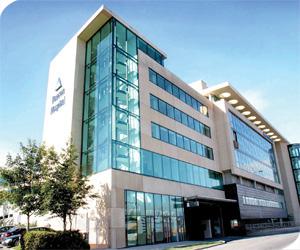Cancer patients are being used as pawns by HSE and private care providers

The south-east stand off is symptomatic of public-private mix. By Sara Burke.
On Thursday’s Morning Ireland programme, there was a very public stand-off between the HSE and Whitfield Cancer Centre (run by the University of Pittsburgh Medical Centre [UPMC]). UPMC threatened to withdraw radiotherapy services for cancer patients in the south-east from the beginning of May next.
(Picture: The Beacon Hospital in Dublin, the majority stakeholder of which is UPMC)
This spat was a very public manifestation of the mess that is Ireland’s public and private mix of healthcare. In a statement issued later that same day, both sides said they were back in discussions with the hope of “resolving outstanding contractual issues”.
So what was this all about?
It is an unusual way to do business: to go on the national airwaves to express disgruntlement with a contractual process and at the same time threaten to withdraw services for cancer patients. Especially when agreement now seems imminent.
At the heart of this issue is money. And poor communications.
Since 2007, Whitfield Cancer Centre, a privately-for-profit facility in Waterford, has been contracted by the HSE to provide radiotherapy treatment in the south-east. And the row is over how much the HSE will pay them for providing that service.
The HSE don’t want to pay double or more than the price of the conventional treatment for this newer, more high-tech treatment and is looking for the best value for public money so that more patients can be treated. Whitfield Cancer Centre is looking for what it expected (which apparently was more than double the conventional rate).
UPMC is an American company, operating in a country where healthcare is largely profit driven. Radiology is one of the most profitable aspects of healthcare. Its start-up costs are high but once you have the right machines and people in place, it can be very profitable.
Up to 2007, cancer patients from the south-east had to travel to Dublin or Cork for treatment. Radiotherapy treatment usually takes a short time – 10 or 20 minutes – and often on consecutive days for a number of weeks. Clearly, travelling 4 to 6 hours for a 10 minute treatment was very inconvenient.
So getting radiotherapy treatment in the Whitfield Cancer Centre has greatly improved the quality of life for cancer patients in the south-east.
Whitfield saw the gap in the market and moved there. It was the first location for the UPMC in Ireland.
Last year Whitfield provided radiotherapy to about 800 patients, 75% of whom were public patients, whom the HSE pays Whitfield to treat.
The row seems messy and dirty and what actually was going on depends on who you ask, but it does seem that there have been poor relations between the HSE and Whitfield, and allegations of delayed payments to Whitfield from the HSE.
But essentially, this stand off was down to money. The conventional treatment costs about €200 a dose but there is disagreement between the sides as to how much should be paid for the more high-tech IMRT. And agreement has not been reached on that.
The HSE contract is important to Whitfield. Given that over 75% of the patients treated are public patients, then 75% of its income comes from public money.
What is most interesting about this story is that it demonstrates the complexity and competing interests of the public and private mix of care in Ireland. Since 2000, there have been a raft of reports from expert groups and independent advisors on how many public radiotherapy facilities there should be in Ireland and where they should be.
The first report (in 2003) found no facilities in the south-east, mid-west and north-west. After much protest, the government agreed to provide services in Waterford and Limerick. The original plan was that all units would be completed by 2011 but now the timeline is that they will not be in place until 2014.
Putting radiotherapy services in place in Ireland was very slow between 2000 and 2005. Since then Mary Harney, and subsequently from 2007 Tom Keane, sped up the roll-out of radiotherapy treatment.
But progress has been slow and in the meantime private facilities have opened. Many of these private facilities (although not Whitfield Cancer Centre) were built with private developers using government tax breaks. So on the one hand, government was planning to develop public facilities but while this took time, the government was also giving tax breaks to private developers building private hospitals where private radiotherapy treatment is provided. As a result, we will have an oversupply of radiotherapy facilities in Ireland.
In the meantime, cancer patients are being used as pawns in a stand off between the HSE and private providers – another fine mess.
